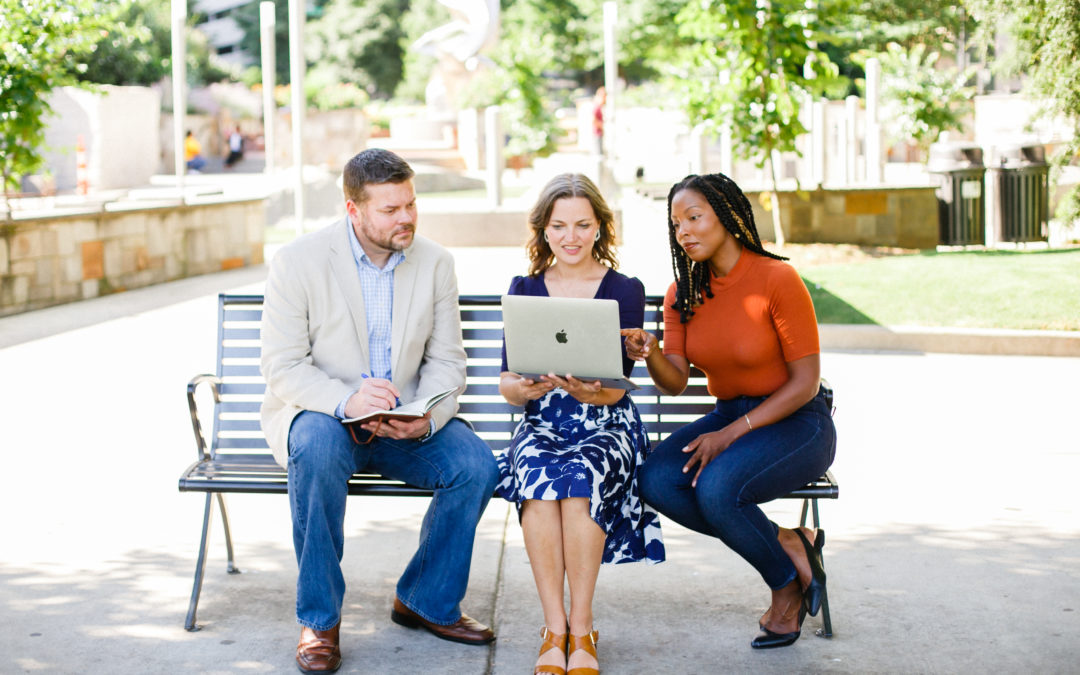Who’s tired?
I’ll admit, I’m pretty beat. The last year and a half have been some of the most challenging of my career and certainly the biggest obstacle Next Stage has ever faced. I’m sure the same could be said for most everyone.
At the same time, Next Stage has grown pretty significantly. We are now a team of six professionals striving to work together to make the world a better place by working at the intersection of social good. Our new focus on working with both private sector companies and nonprofits was itself a pivot brought about by the pandemic.
In so many ways, COVID has been both a giant disruption to our status quo as well as impetus to get more purposeful, more proactive and more actualized in our work. And that includes how our team works together. We have needed to be so much more intentional than when we could simply lean in the doorframe of our office and have an informal, unplanned discussion.
I think we’re far stronger as a team as a result of all this disruption in part because of the infrastructure we’ve built for ourselves with the intention of forging stronger bonds between colleagues.
Here are a few of our strategies on how we keep our team together:
-
- Getting Personal – Work-life balance is a huge area of focus for us at Next Stage. Each of us has had challenges to overcome during COVID as well as personal triumphs that impact our energy and frame of mind. Rather than hide those things away, we have celebrated our personal lives, making it the start of every meeting. “How are you doing?” is the first agenda item of every internal meeting and it is meant to be an intentional check-in. We can’t possibly advance the work of our clients and partners if we aren’t honest with each other about our ups and downs. I feel much closer to my team as a result as we know we have each other’s backs.
-
- Slack to the Rescue –I will admit that there was entirely too much texting going on early in Next Stage’s founding. And while that graduated to Google chat, it wasn’t particularly strategic. In 2020, we implemented Slack as a communication tool, allowing for channels devoted to specific clients, projects, topics and themes. My favorite Slack channel is for non-work updates where everyone is encouraged to share information unrelated to the daily grind. Here one is likely to find photos from the weekend, discussion about world events and musings about life. The channels form an incredible time capsule about all of the things we have experienced since March 2020.
-
- Asana in the House – If Slack served to build the framework for relationship-building that was lost as we worked from home, Asana surely created the infrastructure we needed to get the work done. Previously our team relied on a mixture of online tools to stay contemporary with each other and our projects, but as the firm grew, so too did our need for a project management platform. Asana has strengthened our team by allowing for passive observation on all aspects of our work both internal and external. Now everyone can know what is happening, whether they are directly involved in the project or not. This has been essential as we’ve engaged in so much remotely.
- Deep Dive Wednesday – Our team meets three times each week, and unlike our Monday meeting when the agenda is focused on all of our project work, our Wednesday meetings are committed to a handful of key topics for a deep dive. One of the things missing from our team in the time of COVID is collaborative brainstorming, a real hallmark of our firm. If there is a whiteboard around, you can bet that the Next Stage team is up mapping the future. But that is much more difficult digitally, so we committed our Wednesday staff meeting to one or two topics where we could deeply explore together. The result is increased engagement and problem-solving.
- Friday Wins – We end our week with a 30-minute session focused on our “wins” – the good stuff that happened throughout the week that lifts our spirits and puts winds in our sails. This is a perfect way to wind down before the weekend, with success-focused dialogue that makes everyone feel good. And it totally works, even during weeks that have been more challenging than not. By focusing on what worked and what made us most proud, we are able to source strength from each other to keep on keeping on.
- Asana in the House – If Slack served to build the framework for relationship-building that was lost as we worked from home, Asana surely created the infrastructure we needed to get the work done. Previously our team relied on a mixture of online tools to stay contemporary with each other and our projects, but as the firm grew, so too did our need for a project management platform. Asana has strengthened our team by allowing for passive observation on all aspects of our work both internal and external. Now everyone can know what is happening, whether they are directly involved in the project or not. This has been essential as we’ve engaged in so much remotely.
As we go back to meeting in person more often and ultimately working out of our new office (more on that soon!), these changes to how we build team will absolutely stay. They have seriously made all the difference during the roller coaster of the last 18 months.
